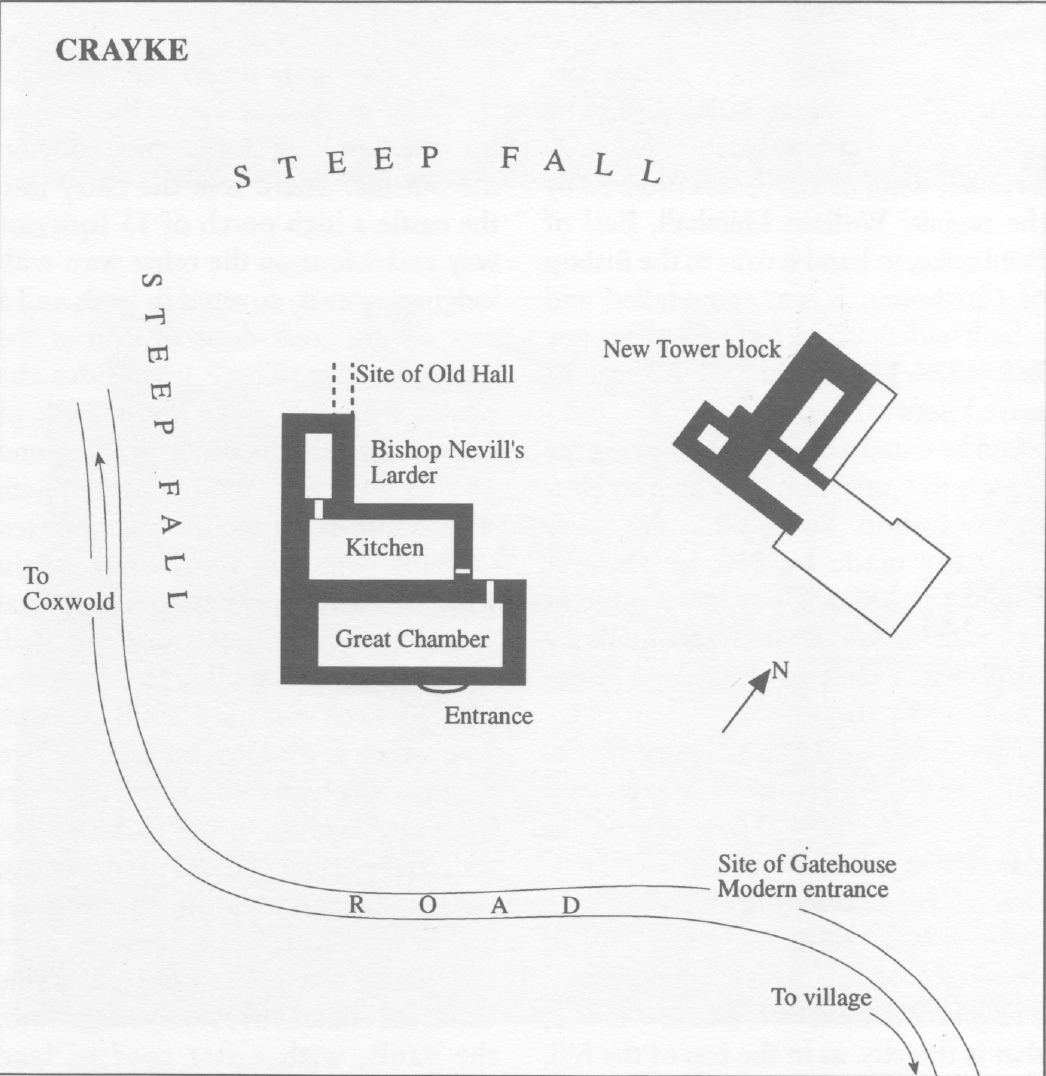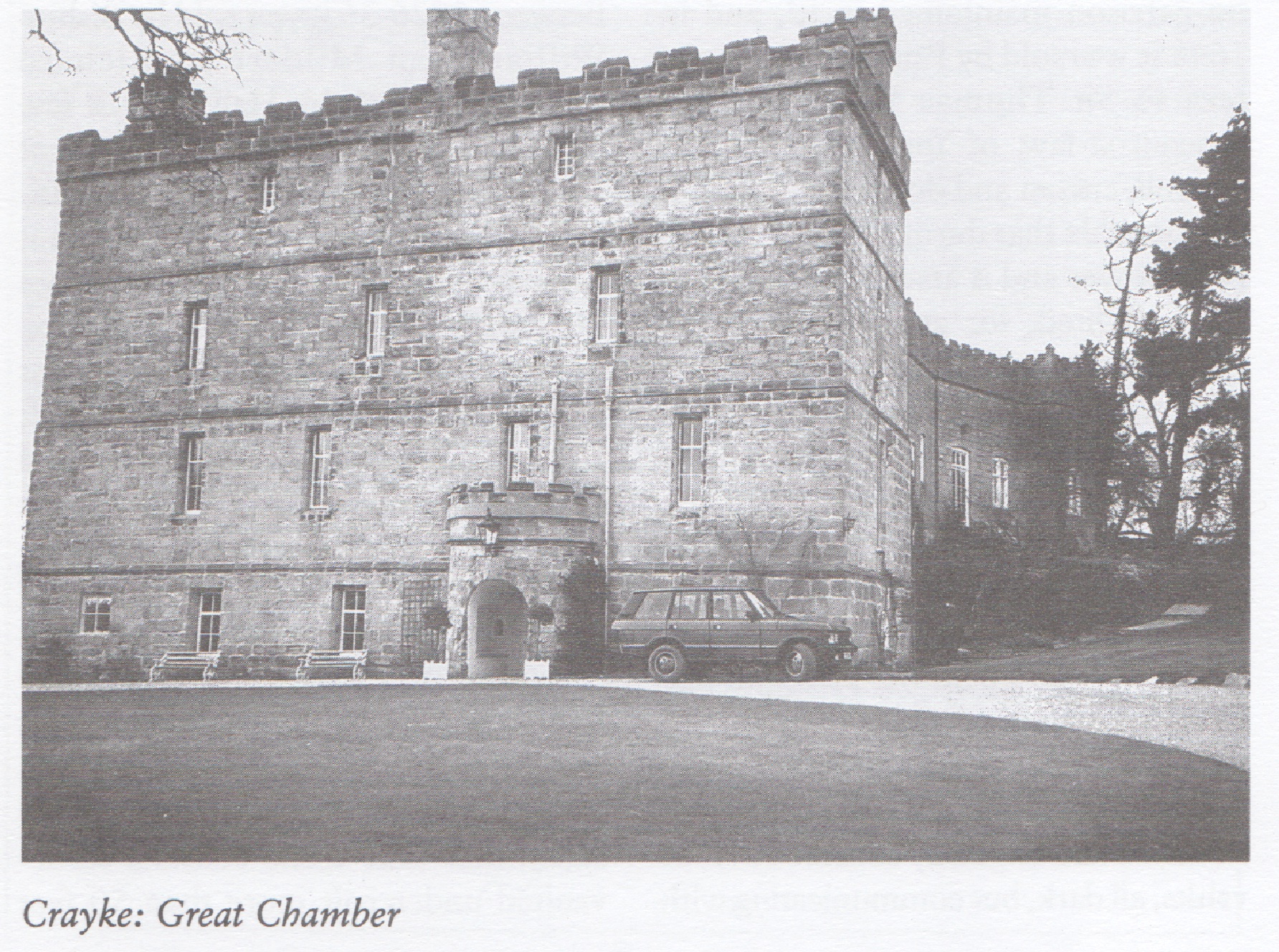
Site of a much altered 12th century motte and bailey castle of the bishops of Durham situated on the summit of Castle Hill
, 3.25km ENE of Easingwold. A description of the site made early in the 19th century still applies: the castle, church, and village stand on the summit of a lofty
eminence, rising from an extensive plain, steep and inaccessible on every side but on the south, where the approach is gradual
. As originally built it probably comprised a circular motte at the higher western end of the hill, immediately north of the present modernised buildings, with a possible kidney-shaped bailey to the east and south. It now comprises much restored 15th century buildings with adjacent, to the NE, the ruinous basement of a tower block. The castle is occupied and stands in private grounds, but it can be easily seen from the road.

The motte and bailey was founded between 1100-95 and is probably the castle of Crek
taken for King John by one of his top commanders, Fawkes de Breaute, who, in 1217, was ordered by the regent, William Marshall, Earl of Pembroke, to hand it over to the Bishop of Chichester. It was remodelled and rebuilt with masonry by Bishop Anthony Bek (1284-1311), and King Edward III stayed here on the 19th October 1345 when he dated a document allowing the Prior and Convent of Durham to elect a new bishop. Some additions were probably made by Bishop Thomas Langley (1406-37), but more substantial additions were definitely made by Bishop Robert Nevill (1438-57) between 1441-50.
Between 1536-43 it was visited by Leland who calling it both Crage
and Crek
castle wrote There remains at this time small show of any old castle that has been there. There is a hall with other offices, and a great stable vaulted with stone of a meatly ancient building. The great square tower [the New Tower] that is thereby, as in the top of the hill, and supplement of lodgings, is very fair, and was erected totally by Nevill, bishop of Durham
. The supplement of lodgings
referred to by Leland are thought to mean the Kitchen and Larder added to the Great Chamber.
A survey made between 1560-70 states The Castle of Crake [i.e. the New Tower] is built of hard stone, the walls thereof five foot thick; the same is all vaulted underneath throughout and is three storeys high above the vault. This house is all covered over with lead and in reasonable good repair. The groundwork of the house or storey, wherein the hall is, is about 40 foot long and 27 foot wide on the outside; and the house or storey wherein the parlour is, is 42 foot long and 33 foot wide on the outside. There is at the entry into the castle a high porch of 15 foot one way and 9 foot on the other way, with lodgings over it, covered in lead; and a new strong great door of iron at the entrance to it. There is, besides the castle, afore, an older house built of stone walls of 58 foot long one way and 18 foot wide, with a roof covered with slate in sore decay and the timber rotten in many places, of four storey height with the vaults, and guttered with lead round about the roof and embattled. One other house, joining to this storey, of 22 foot one way and 20 foot the other way, which is the kitchen. In it are two ranges with a high roof and a vault under it covered with slate and guttered; the walls thereof cracked and in sore decay, ready to fall, under—propped with stays and props. At the south west corner of this house one other house of stonework, the walls of five storey height with the vault, with a flat roof of lead containing 18 foot one way and 12 foot the other way, in good repair. There is, adjoining to this, old walls of a house, which, as it seems, has been the hall of these old houses before the new castle was built. There is a barn with a thatched roof, new built, weather-boarded from the eaves to the ground, of 48 foot long and 24 foot wide, of late days built. There is an old gatehouse, the roof whereof is gone all except a few pieces of timber that is rotten; but for far better away than remain to lose all together
.

In 1586 Bishop Richard Barnes was compelled to lease the castle to Queen Elizabeth I who, in March 1587-8 granted a lease of it to Sir Francis Walsingham who, in the same year sold his interest to a Jolm Theker, and from this time there was a succession of lessees. During the Civil War it was twice ordered to be rendered untenable and no garrison maintained in it
, and in 1648 it was sold by Parliamentary trustees to Sir Thomas Widderington, serjeant-at-law, of York, and Thomas Coghill, citizen and draper, of London. It is possible that during this period the New Tower and it associated buildings were slighted, for at the Restoration when the castle was restored to Bishop ]ohn Cosin, he complained that the owner during the Civil War had injured and dismantled the castle
.
A visitor to the castle in about 1780 described the New Tower block as comprising the remains of several vaults, which now lie open: the principal one to the south has a passage to a vault on the east, greatly ruined, and one to the north, now perfect: it seems that this structure had originally consisted of four vaults, all dark, but communicating with one another: the centre was a kind of column in which there is a staircase leading from the superstructure to the vaults; passing up these stairs, we ascended into a small apartment or turret, with a stone roof, of groined arching, having a circular opening in the centre: the rest of the superstructure is all gone, so that it is impossible to form any judgment what its original figure, or what extent it was
.
Of the Great Chamber block he wrote the hall, which we presumed by the ruins had stood adjacent to the tower, is gone down; the tower [Great Chamber], which forms an oblong square, fronting to the south, and built of durable freestone, is now used as a farmhouse; the walls are of a remarkable thickness, and the lower apartments seem to have been constructed for prisons, and not as household offices, though above ground
.
Between 1826-36 it was sold by Bishop William Van Mildert to Richard Thompson of Kirby Hall, who a few years later sold it to William Waite of Holdgate, near York, and in 1869 a visitor wrote In recent years it [the Great Chamber] has been made the residence of Captain Waite. - who is most anxious to conserve everything that remains of the Castle, of which he is the owner
.
Sometime after 1890 it was purchased by Stephen Cliff, and in 1923 the Great Chamber was said to have been restored within recent years and made habitable, and is now, with some additions, used as a shooting box
. In 1959 it was purchased by Mr. T. Hingham and when advertised for sale in 1991 for an asking price of £800,000 the advert stated that The castle boasts a stone-vaulted undercroft more than 50 feet long, once used as a cow shed but subsequently turned into a large kitchen and dining area
. It also noted that the hill upon which it stands is the hill that the Grand Old Duke of York
marched his men up and down. In 1991-2 it was used as a guest house but has since reverted to a private residence.